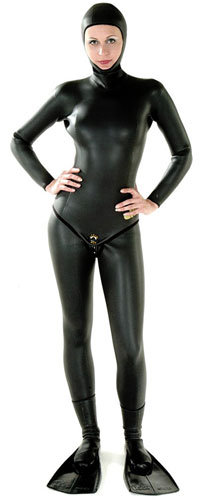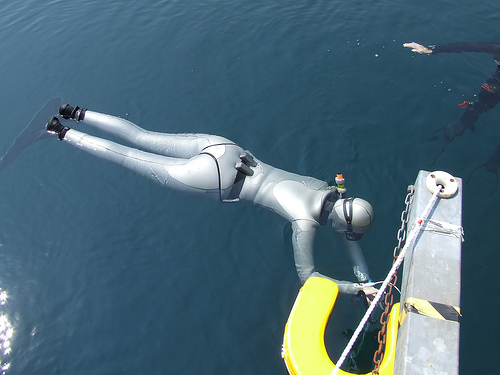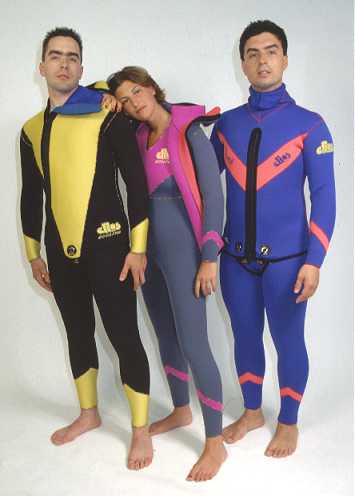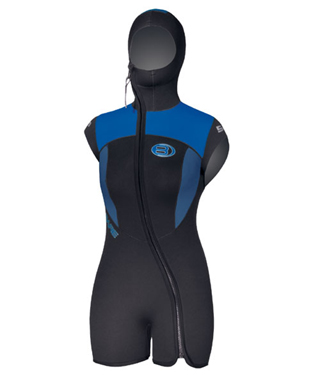-
Design differences between Scuba & Freediving Wetsuits
Water transports heat much better than air. That's why air at 75ºF, 23º below our body temperature, feels fine and we can stay warm as long as we want, but water at 75ºF will suck heat from our bodies and chill us in a few hours. Basically, the job of a wetsuit is to hold a layer of air next to our skin to insulate our bodies from the water.
The way wetsuits work is to trap bubbles of heat-insulating nitrogen gas inside neoprene rubber to create a layer of so-called foam rubber, which is then covered with a smooth skin of neoprene and/or a layer of stretchy nylon fabric.
Wetsuit neoprene is usually called a closed-cell foam, meaning each bubble is completely surrounded by neoprene within the foam, and there are no connections between bubbles.
Density
If you make a foam rubber with larger bubbles and thinner walls around each bubble, i.e. more nitrogen gas and less neoprene rubber, you'll get more insulating effect. This is called low density neoprene by the manufacturers. Such material will be warmer, softer and stretch more, making for a much warmer and more comfortable suit.
The downside of low density neoprene is that it compresses a lot when you go deeper in the water, becoming thinner, and as it gets thinner, it's thermal protection decreases.
For freediving, snorkeling and surfing, where the majority of one's time is spent at the surface, low density neoprene can be the way to go. If you're going down deep and staying down like you do with scuba or surface-supplied diving (hookah diving) though, you want a suit made of neoprene that doesn't compress as much as pressure increases.
Most manufacturers make 3 grades of neoprene: low- medium- and high-density, so that people can chose a suit that compresses less with depth. In medium density and high density foam neoprene, the bubbles are made progessively smaller, and the walls of rubber around each bubble thicker so that the suit compresses less under pressure. The denser the neoprene, though, the less insulating power it has, and the less stretchability it has.
Most scuba diving suits are made of high density neoprene so that they will maintain more even insulating properties at all depths; and most freediving suits are made of low- or medium-density material.
Smoothskin vs Lining
The other fator in wetsuit design is the application to a layer of nylon/lycra fabric to the surface of the neoprene. Neoprene rubber is a fairly soft material, and attaching fabric dramatically increases the durability of the suit. Manufacturers usually refer to neoprene with fabric bonded to the surface as "lined," "nylon lined," "jersey lined," or they invent fancy names like "superstretch lined." Neoprene sheeting with with a smooth, bare rubber surface is usually referred to as "smoothskin" althoug a few manufacturers erroneously refer to smoothskin surfaces as "open cell" which is wrong because open cell refers to foam rubbers that have bubbles that connect with each other, creating what is also known as a sponge rubber. There is a true open cell rubber surface used in spearfishing suits that we will describe later, though, but it's important not to confude open cell foam rubber with the smooth rubber protective coating on the surface of closed cell foam rubber.
Most scuba divers get nylon-lined neoprene because they feel that the stress of straps, weight belts, sliding over the edge of boat gunwhales, etc. will abrade smoothskin neoprene too easily and the suit won't last very long. I'm not aware of any company making smoothskin suits out of high density neoprene for scuba diving nowadays, although maybe they exist.
Bonded fabric does cause some disadvantages compared to smoothskin, though:
- Fabric dramatically reduces the stretch of the neoprene, resulting in a poorer fit. Poorer fit means more leakage of water thorugh the suit, making you colder.
- Also, less stretch in your chest and abdomen area means less efficient breathing, this is one of the major reasons serious freedivers avoid nylon lining and go with smoothskin..
- Fabric lining on the inside of a suit makes it easier to put on the suit when the fabric is dry. When the fabric gets wet, though, the nylon sticks to the skin and wet nylon lined suits are very hard to put on
- Smoothskin neporene dries almost instantly, but fabric takes a long time to dry, meaning if you take a nylon-lined suit off, it will be a while before it dries and is easy to put on again.
- Fabric lining causes more frictional drag in the water than smoothskin does, meaning more energy expenditure and less efficiency swimming. This is the other major reason freedivers wear smoothskin suits.
- fabric lining causes an "evaporative cooling" effect.
Have you ever held up a wet towel in front of a fan, or in a breeze outside, and noticed that the towel gets very cold? This is because as water evaporates it cools its surroundings (actually, to get really geeky- it absorbs heat from its environment to account for the entropy change as the water goes from liquid to vapor form : ) )
With my smoothskin suits, when I get out of the water, the water just beads off, and the suit is dry often within less than a minute. My fabric lined suits, though stay wet for a long time, and if you get out into a wind, or a moving boat, you actually get a refrigeration effect, and can get seriously chilled walking up from the shore or travelling in a boat. In particular, if you keep your hood on, your head can get really chilled, which causes your body to lose heat faster than anything else. This is why if you are going diving in cold weather in a boat and will be wearing a fabric lined wetsuit, you should bring along a windbreaker jacket with a hood to put on over your suit for the ride in the boat after you come out of the water.
Zippers
Freedivers wear suits made in a zipperless design, with high-waisted leggings and a pullover top with an attached hood and bodysuit-style tail that pulls through the legs, because:
- zippers reduce flexibility, and reduce ability to breathe maximally
- Zippers cause more drag in the water, reducing swimming efficiency
- Zippers leak a small amount, reducing warmth
- Having an attached hood rather than a hood with a zippered neck means that there is no water leakage around the neck
Examples of zipperless freediving suits:


In my experience, it's not possible to put on a suit made out of high density neoprene unless it has zippers. The material just isn't stretchy enough, and almost all scuba suits have zippers. They are also made out of thicker material, since they leak more and don't insulate as well. A common design is to wear a one-pice suit with a zipper up the back, and then to pull over a 7 mm step-in jacket, like these examples here:


I thought it might be interesting to compare divers going in very cold water with scuba suits vs a smoothskin freediving suit.
First, these divers are going scuba diving in water at 5ºC (41ºF) the cameraman mentions to the first diver in the vidoe that she is wearing a total of 13 mm (treize millimetres) of neoprene. BTW, Plongée Percée means "Diving Percée." Point Percée (Pierced Point) is a famous tourist site on the Atlantic coast of Quebec in Canada, where divers like to interact with the local grey seals (phoque gris, pronounced "fock gree" by the divers in the video)
Now, here's a freediver wearing a 5 mm Elios smoothskin suit in water at 3.8ºC (39ºF)
In my experience, freediving suits are incredibly warmer than scuba suits. The difference is like night & day. Also freediving suits are so soft and comfortable that once you're in the water it almost feels like you don't have anything on, compared with scuba suits. Just my 2 cents worth.
Here are a couple of links to pages with information you may find interesting:
http://atactv.com/freediving-wet-suits/ (note, there's a very important little piece of info in the video on this page: how to avoid the problem of hood squeeze that can arise with attached hoods by making an equalizing pinhole over your ears)
http://www.freediveblog.com/2012/02/...e-you-wearing/
So, is it possible to wear freediving suits for scuba, or scuba suits for freediving. Well, neither is optimal, but people are doing both here in Toronto. I personally wouldn't get worried about trading in a suit I already have unless I was going for hardcore performance. IME all wetsuits wear out within a few years if you use them a lot, so you can get a new optimized suit when the one you have wears out, IMO.
Also, I personally think the concern about smoothskin rubber wearing out too fast when scuba diving is a bit overblown. I've done it, even going into the water from rocky shores, and haven't done any damage. Also, neoprene is easy to repair. I keep a can of neoprene glue in my bag, and have have fixed torn gloves and booties and holes in suits right on the spot. When I was a student in uni. I had a friend who had a smoothskin suit that she wore scuba diving all through her student days, it worked just fine for her, and didn't get seriously damaged.
I also found this discussion useful http://www.scubaboard.com/forums/sno...ing-suits.html , your mileage may vary.
Finally, one last item for discussion:
Open Cell Spearfishing Suits
The spearfishing people have invented a solution for suit durability while maintaining warmth by creating what they call an open cell-inside design. The manufacturer gets neoprene with fabric bonded to both sides and slices it through the middle, resulting in foam neoprene with fabric on the outside and a layer of open cells on the inside surface. They then make a suit with fabric on the outside and a layer of open cells on the inside.
These suits are very sticky on the inside, and the wearer has to lubricate the inside of the suit liberally with soap, or hair conditioner, or some other slippery substance to get them on. once it's on, though, the suit bonds itself to your body and you have virtually no leakage. I've never worn one of these suits, so can't speak from experience, but I've talked to some people who have, and they say thay can do a whole dive with no water leaking into the main body part of the suit. Picasso, Omer and Elios seem to be the most popular manufacturers for this type of suit. Maybe someone on MerNetwork would be able to pitch in with some more information?
Last edited by AptaMer; 01-10-2014 at 02:55 PM.
-
For the past 8 years I've dove a Henderson Gold Core "skin in" style suit. Skin in style suits should be lubed before entry, as any moisture (sweat) on the skin will cause them to stick, even though it's supposed to slide. Watch fingernails, as it's easy to pop a hole. No glue will stick to the surface treatments, so repairs can be hard.
For additional warmth, men should shave body hair to allow the neoprene to seal better to the skin.
Diving around zebra mussels will cut up almost any wetsuit. I have deep cuts in the harder rubber kneepads on my suit from them, and a skin suit will suffer worse. So do be careful diving infested waters.
Also, there are some "skin 2" suits with the nylon embedded in the neoprene to add strength.
-
Thanks for this information AptaMer.
-
I found a great page from Pacific Coast Freediving on how to choose a wetsuit.
http://www.pacificcoastfreediving.co...commendations/
 Posting Permissions
Posting Permissions
- You may not post new threads
- You may not post replies
- You may not post attachments
- You may not edit your posts
-
Forum Rules





 Reply With Quote
Reply With Quote







Bookmarks